Places to Visit
Pokhara is known as a major tourist attraction in whole Nepal. Some important places of visit are:
1. Lakeside and Tal Barahi
2. Devi's Falls and Gupteshwor Cave
3. World Peace Pagoda
4. Sarangkot
5. Bindabasini Temple and the old market place below the temple
6. Seti river
7. Mahendra Cave, Bat Cave and the Kali river
8. Kahun Danda (hill located at north-east of the city)
9. Armala Village
10. Nau danda, Kande, Lumle -(situated in the outskirts of Pokhara) Pokhara has her unique festivals.
Festivals like Gai Jatra, Bhairab Naach (Bhairab dance), Krishnastami add their own colors to the beauty of Pokhara.
 Panoramic View of Vindavasini Temple
Panoramic View of Vindavasini Temple
 Panoramic View of Devi's Fall
Panoramic View of Devi's Fall
 360 Degree Panoramic View of Fewa Lake
360 Degree Panoramic View of Fewa Lake
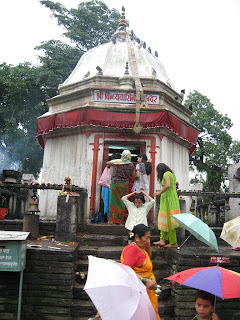
Pokhara (पोखरा) is a city in central Nepal located at 28.24 N, 83.99 E,, 198 km west of Kathmandu. It is the capital of Kaski District, Gandaki Zone and the Western Development Region. It is also one of the most popular tourist destinations in Nepal. It is second largest city (With the population more then 200 thousend) of nepal.
N, 83.99 E,, 198 km west of Kathmandu. It is the capital of Kaski District, Gandaki Zone and the Western Development Region. It is also one of the most popular tourist destinations in Nepal. It is second largest city (With the population more then 200 thousend) of nepal.
Pokhara is situated in the northwestern corner of the Pokhara Valley, which is a widening of the Seti Gandaki valley The Seti River and its tributaries have dug impressive canyons into the valley floor, which are only visible from higher viewpoints or from the air. To the east of Pokhara is the municipality of Lekhnath, another town in the valley.
In no other place the mountains rise so quickly, within 30 km, from 1000 m to over 8000 m. The Dhaulagiri, Annapurna and Manaslu ranges, each with peaks over 8000 m, can be seen from Pokhara and there is a lake named Phewa Lake, two caves (Mahendra and Gupteswar) and an impressive falls(Patale Chhango or Devi /David's Falls) where the water from the Phewa Lake thunders into a hole and disappears. Due to this sharp rise in altitude the area of Pokhara has one of the highest precipitation rates of the country (over 4000 mm/year). Even within the city there is a noticeable difference in the amount of rain between the south of the city by the lake and the north at the foot of the mountains.
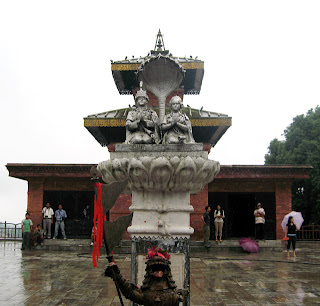
The climate is sub-tropical but due to the elevation the temperatures are moderate: the summers usually have a bearable 30 - 35°C; the winters average around 15°C and have no frost.
In the south the city borders on Phewa Tal (a lake, 4.4 km², about 800 m above sea level), in the north at around 1000 m it touches the base of the Annapurna mountain range. From the southern fringes of the city one has an exceptional view of the Himalaya with 3 eight-thousanders (Dhaulagiri, Annapurna, Manaslu) and, in the middle of the Annapurna range the wonderful Machapuchare ('Fishtail') with close to 7000 m. This beautiful mountain dominates the northern horizon of the city and its name derives from its twin peaks, not visible from the south.


Pokhara is quite a modern city with only few touristic attractions in the town itself. Most interesting is the old centre in the north of the city (purano bazar) where still many old shops and warehouses in the Newari style can be found. Mule caravans still arrive there from Mustang.
On a hill overlooking Phewa Tal from the south is the World Peace Stupa (at 1,113 m) QTVR built in 1996 with a view of the lake, across the city and of the snow peaked mountain range consisting of namely, Fishtail, Annapurna and Dhaulagiri Himals (mountains).
Temples worth visiting in the older part of town are Bindhyabasini Mandir and Bhimsen Mandir, the latter with erotic carvings; another temple, Barahi Mandir, is located on a tiny island on Phewa Tal. Not accessible and only visible from the lake is the royal summer residence (called Ratna Mandir) at the lake in Lakeside.
The best viewpoint of Pokhara is Sarangkot (1600 m) to the west of the city. Paths and a road lead to the top from where one can enjoy spectacular views of the Annapurna range, Manaslu, Dhaulagiri and the city itself.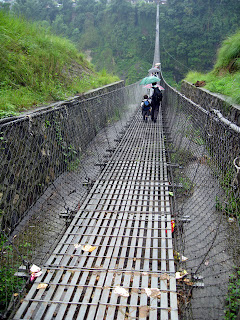

 The modern commercial city centre at Chiple Dhunga and Mahendrapul (now called Bhimsen Chowk, named after a Shahid(Martyr) in Jana-aandolan II, April, 2006) is halfway between the lake and Purano Bazar, the old centre. Apart from this there are several subcentres in other parts of town: in the north in Bagar, in the south between Prithvi Chok and Srijana Chok (mainly hardware stores), and in the east, on the other side of the Seti, in Ram Bazar.
The modern commercial city centre at Chiple Dhunga and Mahendrapul (now called Bhimsen Chowk, named after a Shahid(Martyr) in Jana-aandolan II, April, 2006) is halfway between the lake and Purano Bazar, the old centre. Apart from this there are several subcentres in other parts of town: in the north in Bagar, in the south between Prithvi Chok and Srijana Chok (mainly hardware stores), and in the east, on the other side of the Seti, in Ram Bazar.



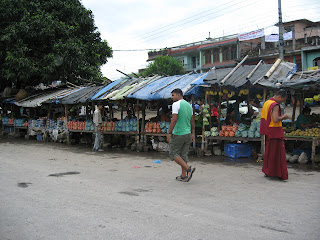
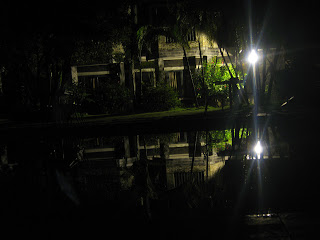
PICTURES I WANTED TO CLICK



Pokhara is known as a major tourist attraction in whole Nepal. Some important places of visit are:
1. Lakeside and Tal Barahi
2. Devi's Falls and Gupteshwor Cave
3. World Peace Pagoda
4. Sarangkot
5. Bindabasini Temple and the old market place below the temple
6. Seti river
7. Mahendra Cave, Bat Cave and the Kali river
8. Kahun Danda (hill located at north-east of the city)
9. Armala Village
10. Nau danda, Kande, Lumle -(situated in the outskirts of Pokhara) Pokhara has her unique festivals.
Festivals like Gai Jatra, Bhairab Naach (Bhairab dance), Krishnastami add their own colors to the beauty of Pokhara.
 N, 83.99 E,, 198 km west of Kathmandu. It is the capital of Kaski District, Gandaki Zone and the Western Development Region. It is also one of the most popular tourist destinations in Nepal. It is second largest city (With the population more then 200 thousend) of nepal.
N, 83.99 E,, 198 km west of Kathmandu. It is the capital of Kaski District, Gandaki Zone and the Western Development Region. It is also one of the most popular tourist destinations in Nepal. It is second largest city (With the population more then 200 thousend) of nepal.Pokhara is situated in the northwestern corner of the Pokhara Valley, which is a widening of the Seti Gandaki valley The Seti River and its tributaries have dug impressive canyons into the valley floor, which are only visible from higher viewpoints or from the air. To the east of Pokhara is the municipality of Lekhnath, another town in the valley.
In no other place the mountains rise so quickly, within 30 km, from 1000 m to over 8000 m. The Dhaulagiri, Annapurna and Manaslu ranges, each with peaks over 8000 m, can be seen from Pokhara and there is a lake named Phewa Lake, two caves (Mahendra and Gupteswar) and an impressive falls(Patale Chhango or Devi /David's Falls) where the water from the Phewa Lake thunders into a hole and disappears. Due to this sharp rise in altitude the area of Pokhara has one of the highest precipitation rates of the country (over 4000 mm/year). Even within the city there is a noticeable difference in the amount of rain between the south of the city by the lake and the north at the foot of the mountains.
The climate is sub-tropical but due to the elevation the temperatures are moderate: the summers usually have a bearable 30 - 35°C; the winters average around 15°C and have no frost.
In the south the city borders on Phewa Tal (a lake, 4.4 km², about 800 m above sea level), in the north at around 1000 m it touches the base of the Annapurna mountain range. From the southern fringes of the city one has an exceptional view of the Himalaya with 3 eight-thousanders (Dhaulagiri, Annapurna, Manaslu) and, in the middle of the Annapurna range the wonderful Machapuchare ('Fishtail') with close to 7000 m. This beautiful mountain dominates the northern horizon of the city and its name derives from its twin peaks, not visible from the south.

Pokhara is quite a modern city with only few touristic attractions in the town itself. Most interesting is the old centre in the north of the city (purano bazar) where still many old shops and warehouses in the Newari style can be found. Mule caravans still arrive there from Mustang.
On a hill overlooking Phewa Tal from the south is the World Peace Stupa (at 1,113 m) QTVR built in 1996 with a view of the lake, across the city and of the snow peaked mountain range consisting of namely, Fishtail, Annapurna and Dhaulagiri Himals (mountains).
Temples worth visiting in the older part of town are Bindhyabasini Mandir and Bhimsen Mandir, the latter with erotic carvings; another temple, Barahi Mandir, is located on a tiny island on Phewa Tal. Not accessible and only visible from the lake is the royal summer residence (called Ratna Mandir) at the lake in Lakeside.
The best viewpoint of Pokhara is Sarangkot (1600 m) to the west of the city. Paths and a road lead to the top from where one can enjoy spectacular views of the Annapurna range, Manaslu, Dhaulagiri and the city itself.

 The modern commercial city centre at Chiple Dhunga and Mahendrapul (now called Bhimsen Chowk, named after a Shahid(Martyr) in Jana-aandolan II, April, 2006) is halfway between the lake and Purano Bazar, the old centre. Apart from this there are several subcentres in other parts of town: in the north in Bagar, in the south between Prithvi Chok and Srijana Chok (mainly hardware stores), and in the east, on the other side of the Seti, in Ram Bazar.
The modern commercial city centre at Chiple Dhunga and Mahendrapul (now called Bhimsen Chowk, named after a Shahid(Martyr) in Jana-aandolan II, April, 2006) is halfway between the lake and Purano Bazar, the old centre. Apart from this there are several subcentres in other parts of town: in the north in Bagar, in the south between Prithvi Chok and Srijana Chok (mainly hardware stores), and in the east, on the other side of the Seti, in Ram Bazar.

PICTURES I WANTED TO CLICK




